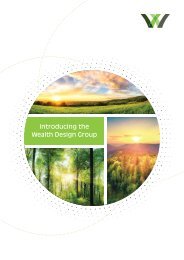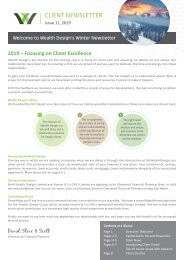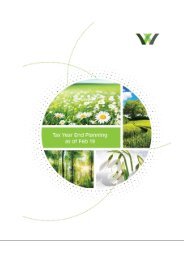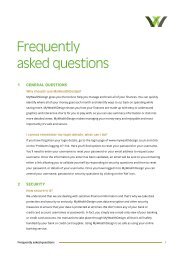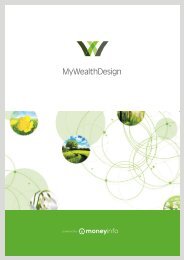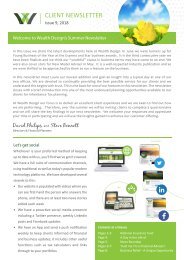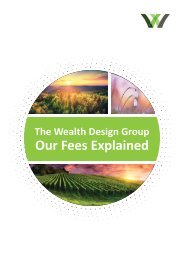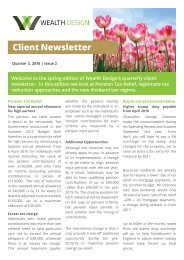The Wealth Design Group Autumn 2017 Budget Guide
This comprehensive 33 page guide to the Autumn Budget in 2017 gives an overview as to what the budget means for employees, the self employers, parents, those at retirement, the retired and estate planners.
This comprehensive 33 page guide to the Autumn Budget in 2017 gives an overview as to what the budget means for employees, the self employers, parents, those at retirement, the retired and estate planners.
Create successful ePaper yourself
Turn your PDF publications into a flip-book with our unique Google optimized e-Paper software.
HUNTER & CO.<br />
Detailed <strong>Autumn</strong> <strong>Budget</strong> <strong>Guide</strong> <strong>2017</strong><br />
1
Contents<br />
Page 3<br />
Pages 4-5<br />
Pages 6-10<br />
Pages 11-12<br />
Pages 13-15<br />
Pages 16-18<br />
Pages 19-20<br />
Pages 21-22<br />
Pages 23-30<br />
12 Quick Tax Tips<br />
<strong>The</strong> <strong>Budget</strong> Background<br />
Investors and Savers<br />
Estate planners<br />
Business Owners<br />
Employees<br />
Retiree/At Retirement<br />
Parent<br />
Main Income Tax Allowances and Reliefs<br />
Authorisation Statement<br />
Hunter & Co (IFA) Limited is registered in England (Company No. 03673023) and is authorised and regulated by<br />
the Financial Conduct Authority: FRN No. 191615<br />
You can check this on the FCA’s Register by visiting the FCA’s website www.fca.org.uk/register FCA number 191615 or by contacting the FCA on 0845 606 1234..<br />
2
12 Quick Tax Tips<br />
1. Don’t waste your (or your partner’s) £11,850 personal allowance in 2018/19.<br />
2. Don’t forget the personal savings allowance, reducing tax on interest earned.<br />
3. Think about any changes you need to make when the dividend allowance is cut.<br />
4. Don’t ignore National Insurance contributions – they are really a tax at up to 25.8%.<br />
5. Think marginal tax rates – the system now creates 60% (and higher) marginal rates.<br />
6. ISAs should normally be your first port of call for investments and then deposits.<br />
7. Even if you’re eligible for a LISA, you still might find a pension is a better choice.<br />
8. Tax on capital gains is usually lower and paid later than tax on investment income.<br />
9. Trusts can save inheritance tax, but suffer the highest rates of CGT and income tax.<br />
10. File your tax return on time to avoid penalties and the taxman’s attention.<br />
11. If you must have a company car, consider a hybrid to save income tax.<br />
12. Don’t assume HMRC doesn’t know: automatic information exchange has started.<br />
3
<strong>The</strong> <strong>Budget</strong> Background<br />
Almost exactly a year ago the Chancellor, Philip Hammond, announced to a surprised House of<br />
Commons that he was making his last <strong>Autumn</strong> Statement. This puzzling news was rapidly explained in<br />
the next few sentences, as the Chancellor revealed that he would be moving onto an <strong>Autumn</strong> <strong>Budget</strong><br />
cycle in <strong>2017</strong>, following a final Spring <strong>Budget</strong> earlier in the year.<br />
A considerable amount of (political) water has flowed under the bridge since Mr Hammond effectively<br />
abolished the <strong>Autumn</strong> Statement. At one point, the March <strong>Budget</strong> did look like his last after he was<br />
forced into a rapid U-turn on increases to Class 4 National Insurance contributions (NICs). <strong>The</strong>n came<br />
a snap election which kicked many of the <strong>Budget</strong>’s measures into a limbo from which they have only<br />
just emerged. Ironically, the pundits generally agree that the election was also the reason why Mr<br />
Hammond remains in post – for the time being.<br />
Thus, Mr Hammond presented his second <strong>Budget</strong> of <strong>2017</strong> against a different – and in many ways more<br />
difficult – backdrop from the first. <strong>The</strong> remnants of his previous Spring <strong>Budget</strong> were still haunting<br />
parliament until the Finance Bill <strong>2017</strong>/19 received Royal Assent just six days before the <strong>Autumn</strong> <strong>Budget</strong><br />
Day. <strong>The</strong> Government is relying on a confidence and supply agreement with the DUP to pass its <strong>Budget</strong><br />
measures, past and present, support which itself cost an unbudgeted £1bn of extra expenditure.<br />
Mr Hammond can at least take some comfort from the financial figures that have emerged since March.<br />
Back in the Spring the Office for <strong>Budget</strong> Responsibility (OBR) was forecasting that the government<br />
would end up borrowing £51.7bn in 2016/17 and £58.3bn (13% more) in this financial year. Ever since<br />
the actual numbers have been improving. <strong>The</strong> latest estimate for last year’s borrowing is £45.7bn,<br />
while seven months into the current financial year, figures released on Tuesday showed borrowing<br />
was £4.1bn less than at the same stage in 2016/17.<br />
This might appear to have given the Chancellor “wriggle room”, but the OBR has made adjustments<br />
to its assumptions, notably productivity growth, which reinstated the Treasury’s limited room for<br />
manoeuvre. <strong>The</strong> OBR has also cut its growth forecast for this year from the 2.0% it saw in March to<br />
1.5%, 0.1% lower than the central assumption made by the Bank of England earlier this month in its<br />
Quarterly Inflation Report. Economic growth further out is also disappointing: the OBR says that by<br />
2021/22 the UK economy will be 2.1% smaller than implied by its March growth forecasts.<br />
Inflation, running at 3.0% on the CPI measure (and 4.0% on the old RPI yardstick), is expected to fall<br />
to 2.4% in 2018 and 1.9% the following year. While working-age benefits generally remain frozen,<br />
the government finances still suffer because of the knock-on effect on index-linked gilts. This was<br />
a problem highlighted in the most recent public sector finance figures, which showed the £6bn<br />
government interest costs in October were the highest ever recorded for that month. However, the<br />
government remains able to borrow 10-year money via the conventional gilts market at a rate of<br />
around 1.25% – just as well with nearly £120bn of borrowing to undertake in 2018/19.<br />
So what did emerge from this first <strong>Autumn</strong> <strong>Budget</strong>? With so many constraints and the lessons of March<br />
firmly in mind, the Chancellor was predictably cautious but, as usual, there were a few surprises, both<br />
good and bad:<br />
4
• An exemption from SDLT on the first £300,000 of property value for first-time buyers (outside<br />
Scotland) buying homes worth not more than £500,000.<br />
• A £1,350 rise in the higher rate threshold for 2018/19, to £46,350, moving towards the 2020/21<br />
target of £50,000. However, this will not apply fully to Scotland, which sets its own higher rate<br />
threshold for non-savings and non-dividend income and, in 2018/19, may well reveal its own<br />
income tax rates on its <strong>Budget</strong> Day, 14 December.<br />
• A £400 increase in the capital gains tax annual exemption to £11,700.<br />
• <strong>The</strong> first inflation- linked increase in the lifetime allowance, to £1.03m – and no changes to the<br />
annual allowance.<br />
• Higher tax on diesel company cars, but no tax charge on workplace supplied electricity to<br />
recharging of employees’ electric or hybrid vehicles.<br />
In this Bulletin we look at the impact of the main changes on various groups of taxpayers. <strong>The</strong><br />
categorisation is inevitably rather arbitrary, so it pays to read all sections. Similarly, several of the tax<br />
planning points – such as those listed below in our 12 Quick Tax Tips – are universal.<br />
If you need further information on how you will be affected personally, you are strongly<br />
recommended to speak to the team at <strong>Wealth</strong> <strong>Design</strong>.
Investors and Savers<br />
<strong>The</strong> Personal Allowance<br />
In their manifesto, the Conservatives reaffirmed their goal of a £12,500 personal allowance by<br />
2020/21. <strong>The</strong> announcement of a personal allowance of £11,850 for 2018/19 is another step on the<br />
way, albeit no more than was required by indexation. However, many people do not even use the<br />
current personal allowance (£11,500 in <strong>2017</strong>/18), and in 2018/19 there will be a gap of over £3,400<br />
between the allowance and the starting point for National Insurance contributions (£8,424). At the<br />
other end of the income scale, some taxpayers will have no personal allowance in 2018/19 because<br />
their income exceeds £123,700, at which point their allowance is tapered to nil.<br />
If you or your partner does not use the personal allowance to the full, you could be paying more tax<br />
than necessary. <strong>The</strong>re are several ways to make sure you maximise use of your allowances:<br />
• Choose the right investments: some investments do not allow you to reclaim tax paid while<br />
others are designed to give capital gain, not income.<br />
• Couples should consider rebalancing investments so that each has enough income to cover<br />
their personal allowance.<br />
• Make sure that in retirement you (and your partner) each have enough pension income. On<br />
their own, state pension provision is enough, be it the new state pension (up to £164.35 a week<br />
in 2018/19) or the old state pension of £125.95 a week (for those who reached State Pension<br />
Age before 6 April 2016).<br />
• If one of you pays tax at no more than basic rate and the other is a non-taxpayer, check whether<br />
it is worth claiming the transferable married allowance (£1,150 in <strong>2017</strong>/18, rising to £1,185 in<br />
2018/19).<br />
<strong>The</strong> Personal Savings Allowance<br />
<strong>The</strong> personal savings allowance (PSA) first took effect in 2016/17. Broadly speaking, if you are a:<br />
• basic rate taxpayer, the first £1,000 of savings income you earn is untaxed;<br />
• higher rate taxpayer, the first £500 of savings income you earn is untaxed;<br />
• additional rate taxpayer, you do not receive any personal savings allowance.<br />
‘Savings income’ in this instance is primarily interest, but also includes gains made on investment<br />
bonds. Although called an allowance, the reality is that the PSA is a nil rate tax band, so it is not quite<br />
as generous as it seems. <strong>The</strong> PSA’s arrival meant that from 6 April 2016 banks, building societies and<br />
National Savings & Investments stopped deducting tax from interest Since the start of this tax year,<br />
UK-based fixed interest collective funds have also paid interest without deduction of tax.<br />
6
If you and your spouse/civil partner receive substantial interest income, it is worth checking that you<br />
both maximise the benefit of the PSA. However, at current miserably low interest rates – even after the<br />
recent base rate increase – you might also want to consider whether you could earn a higher income<br />
by choosing non-deposit investments.<br />
<strong>The</strong> Dividend Allowance<br />
<strong>The</strong> dividend allowance started life in 2016/17. At the time it was part of a reform of dividend taxation,<br />
ultimately designed to raise more revenue. <strong>The</strong> main target was private company shareholders who<br />
use dividends rather than salary to extract profits and thereby avoid National Insurance contributions.<br />
<strong>The</strong> allowance means that in <strong>2017</strong>/18 the first £5,000 of dividends you receive is not subject to any tax<br />
in your hands, regardless of your marginal income tax rate. Once the £5,000 allowance is exceeded,<br />
there is a tax charge, at a higher rate than in tax years before 2016/17. Like the personal savings<br />
allowance, the dividend allowance is really a nil rate band, so up to £5,000 of dividends do not disappear<br />
from your <strong>2017</strong>/18 tax calculations, even though they are taxed at 0%.<br />
This year’s Spring <strong>Budget</strong> announced that the allowance would be cut to £2,000 from 2018/19, a<br />
measure which was finally legislated for a few days before the <strong>Budget</strong> in the Finance (No. 2) Act <strong>2017</strong>.<br />
At worst this change could mean £975 more tax for a higher rate taxpayer and £1,143 more for an<br />
additional rate taxpayer.<br />
<strong>The</strong> Starting Rate Band<br />
In 2016/17, the starting rate band for savings income was launched at £5,000 and a rate of 0%. No<br />
changes to the original band or rate have been made for 2018/19. <strong>The</strong> truth is that most people are<br />
not able to take advantage of the starting rate band: if your earnings and/or pension income exceed<br />
£16,850 in 2018/19, then that probably includes you. However, if you (or your partner) do qualify, you<br />
will need to ensure you have the right type of investment income to pay 0% tax.<br />
Planning Point: If you don’t anticipate using all your personal allowance or personal savings<br />
allowance in <strong>2017</strong>/18 think about creating more income by closing deposit accounts before<br />
6 April and crystallising the interest in this tax year. But beware early closure penalties and<br />
shutting down accounts with better interest rates than are available now!<br />
For next tax year, think about who should own what in terms of investments and savings.<br />
<strong>The</strong> savings and (reduced) dividend allowances mean it is not simply a question of loading<br />
as much as possible on the lower rate taxpayer of a couple. In theory, you will each be able<br />
to receive an income of up to £19,850 a year tax free in 2018/19, but only if you have the<br />
right mix of earnings, savings income and dividends.
Capital Gains Tax (CGT)<br />
Capital gains are currently taxed as the top slice of income, but the rates are lower than those that<br />
apply to income not covered by allowances. Gains are generally taxable at 10% to the extent they<br />
fall in the basic rate band (£33,500 in <strong>2017</strong>/18 and £34,500 in 2018/19) and 20% if they fall into the<br />
higher or additional rate bands. An additional 8% applies to gains on residential property and carried<br />
interest. For 2018/19, the capital gains tax annual exemption will rise by £400 to £11,700.<br />
<strong>The</strong> tax rates and annual exemption mean that if you can arrange for your investment returns to be<br />
delivered in the form of capital gains rather than income, you will often pay no tax on your profits.<br />
While investment decisions should never be made on tax considerations alone, traditionally favouring<br />
capital gains over income when setting your investment goals has been a sensible approach. However,<br />
up to the (reducing) level of the dividend allowance, this is no longer automatically the case.<br />
Planning Point: If you do not use your £11,300 annual exemption by Thursday 5 April 2018,<br />
you will lose it and a possible tax saving of over £3,100. If you have gains of over the exempt<br />
amount to realise, it could be worth deferring the excess until after 5 April to gain another<br />
annual exemption and defer the CGT bill until 31 January 2020.<br />
Individual Savings Accounts (ISAs)<br />
<strong>The</strong> annual ISA investment limit for 2018/19 will be an unchanged £20,000. <strong>The</strong>re will also be no<br />
change in the limit for the Lifetime ISA (LISA), which was launched earlier this year and has so far<br />
attracted much comment but only limited interest. <strong>The</strong> limit for the Junior ISA (JISA), which is attracting<br />
more university-fee-planning investors, will rise marginally from £4,128 to £4,260, as will the child<br />
trust fund (CTF) limit.<br />
ISAs have long been one of the simplest ways to save tax, with nothing to report or claim on your tax<br />
return. <strong>The</strong> arrival of the LISA this year has complicated matters, as the new variant sits somewhere<br />
between the traditional ISA and a pension plan. If you are thinking of a LISA instead of either of these,<br />
you would be well advised to seek advice before taking any action.<br />
Over time substantial sums can build up in ISAs: if you had maximised your ISA investment since they<br />
first became available in April 1999, you would by now have placed over £185,000 largely out of reach<br />
of UK taxes.<br />
Planning Point: <strong>The</strong> cut in the dividend allowance from 2018/19 means that your ISAs<br />
should be reviewed. If you have not already done so, it makes sense to undertake a review<br />
before making any year end top up.<br />
8
Venture Capital Trusts (VCTs) and Enterprise Investment Schemes (EISs)<br />
VCTs and EISs have been subject to many rule changes in recent years, with some significant reforms<br />
– prior to those announced in the <strong>Budget</strong> - being introduced two years ago. Those 2015 reforms<br />
changed the nature of some schemes; for example, VCTs are no longer able to make new investment<br />
in management buy-outs (MBOs). <strong>The</strong> latest proposals include:<br />
• A “risk to capital” requirement This is designed to focus the investment made by VCTs, EISs<br />
and seed enterprise investment schemes (SEISs) on companies where there is a real risk to<br />
the capital being invested, and exclude from investment those companies and arrangements<br />
intended to provide “capital preservation”. This requirement will take effect from Royal Assent<br />
of the Finance Bill in Spring 2018, subject to state aid rules.<br />
• Increased limits for investments in knowledge-intensive companies <strong>The</strong>re will be a doubling<br />
of the amount an individual may invest under the EIS in a tax year to £2 million, provided any<br />
amount over £1 million is invested in one or more knowledge-intensive companies. Similarly,<br />
the annual investment limit for knowledge-intensive companies receiving investments under<br />
the EIS and from VCTs will double to £10 million, although the lifetime limit will remain at<br />
£20 million. Knowledge-intensive companies will be able to use the date when their annual<br />
turnover first exceeds £200,000 to determining the start of the initial investing period, instead<br />
of the date of first commercial sale. All these changes take effect from 2018/19, subject to state<br />
aid rules.<br />
• Relevant investment <strong>The</strong> current rules which exclude certain investments made before 2012<br />
from the lifetime funding limits for companies receiving investments under the EIS and VCT<br />
scheme will be scrapped from 1 December <strong>2017</strong>, subject to state aid rules.<br />
• Further VCT rules tightening Several other changes will be made to VCT rules in the Finance Bill<br />
<strong>2017</strong>-18, including an increase in the proportion of VCT funds that must be held in qualifying<br />
holdings to 80% and an anti-abuse rule to prevent loans being used to preserve and return<br />
equity capital to investors.<br />
Interest in VCTs, EISs and SEISs has grown as more aggressive forms of tax planning have come<br />
under sustained (and largely successful) HMRC attack and pension opportunities have been further<br />
constrained. In 2016/17 there was a 28% increase in VCT investment, which might help to explain the<br />
measures announced by Mr Hammond.<br />
Planning Point: <strong>The</strong> best VCT offers can sell out quickly – even before you read about them<br />
in the weekend press. Supply is likely to be disrupted by the proposed changes, so do be<br />
sure you let us know if you want to make any VCT investment in <strong>2017</strong>/18.<br />
9
Pay Later, Not Now?<br />
For higher and additional rate taxpayers, there can be a case for considering the options for tax<br />
deferral, once the decision on which sector to invest in has been made. <strong>The</strong> potential advantages and<br />
disadvantages of tax deferral include:<br />
• What would be going to the Treasury instead remains invested, enhancing potential returns.<br />
• <strong>The</strong>re is the possibility that tax rates will be lower when the investment is realised. <strong>The</strong> opposite<br />
risk is that the 50% top tax rate could reappear under a new government, which might emerge<br />
at any time.<br />
• Some tax liability might disappear completely. For example, under current rules there is<br />
generally no capital gains tax on death.<br />
• <strong>The</strong> investor may change their country of residence, giving rise to a lower tax rate or possible<br />
tax savings during the period of transition between the old and new homes.<br />
<strong>The</strong>re is a variety of tax deferral options available but, as ever, advice is needed in making the ‘customer’<br />
a client of HMRC.<br />
10
Estate planners<br />
Nil Rate Band<br />
<strong>The</strong> nil rate band reached its current level of £325,000 in April 2009. It has been frozen since then and<br />
the freeze will continue until at least April 2021. Had the nil rate band been increased in line with CPI<br />
inflation, it would be about £400,000 in 2018/19.<br />
A frozen nil rate band drags more estates into the IHT net and, if you are already caught, adds to the<br />
amount of tax that will be levied. Since April 2009, average UK house prices are up by about 41%,<br />
according to Nationwide, and UK share prices have risen by about 100% (March 2009 marked their low<br />
point in the wake of the financial crisis).<br />
Residence Nil Rate Band<br />
<strong>The</strong> Residence Nil Rate Band (RNRB) came into effect on 6 April <strong>2017</strong>with an initial figure of £100,000.<br />
For 2018/19 the RNRB will rise to £125,000, en route to reaching £175,000 in 2020/21, after which<br />
increases will be inflation-linked. It does help to ease the burden of IHT for many estates, but it is by<br />
no means a panacea. <strong>The</strong> government’s IHT tax take is still expected to carry on increasing according<br />
to the OBR projections.<br />
IHT Yearly Exemptions<br />
<strong>The</strong> nil rate band freeze makes the yearly IHT exemptions all the more important:<br />
• <strong>The</strong> £3,000 annual exemption. Any unused part of this exemption can be carried forward one<br />
tax year, but it must then be used after the £3,000 exemption for that year. So, for example,<br />
if you made a gift of £1,000 covered by the annual exemption in 2016/17, you can make gifts<br />
totalling £5,000 covered by the annual exemption in <strong>2017</strong>/18 by 5 April 2018.<br />
• <strong>The</strong> £250 small gifts exemption. You can make as many outright gifts of up to £250 per individual<br />
per tax year as you wish free of IHT, provided that the recipient does not also receive any part<br />
of your £3,000 annual exemption.<br />
• <strong>The</strong> normal expenditure exemption. Any gift that you make is exempt from IHT if:<br />
o it forms part of your normal expenditure; and<br />
o taking one year with another it is made out of income; and<br />
o it leaves you with sufficient income to maintain your usual standard of living.<br />
11
Will Review<br />
<strong>The</strong> arrival of the RNRB should have meant that you reviewed your Will. One of the stranger<br />
consequences of another nil rate band – albeit one only available at death – has been that it may<br />
require you to make gifts away from a surviving spouse or civil partner on first death, if you want to<br />
minimise your joint IHT bill.<br />
Planning Point: If you are making an annual exemption gift by way of a cheque, remember<br />
that legally the gift is only made once the cheque is cleared. Thursday April 5 is the final<br />
banking day of <strong>2017</strong>/18, so a cheque given on the previous Easter weekend may not clear<br />
in time.<br />
12
Business Owners<br />
Corporation Tax Rate<br />
<strong>The</strong> rate of corporation tax fell to 19% for the financial year starting on 1 April <strong>2017</strong>. A further reduction<br />
to 17% from April 2020 was legislated for in Finance Act 2016. Although a while ago there was some<br />
talk about cutting rates to below 15%, this idea has disappeared along with hopes of a government<br />
financial surplus by 2020.<br />
<strong>The</strong> falling rate of corporation tax is one of the reasons why the reform of dividend taxation was<br />
introduced from 2016/17. Lower corporation tax rates strengthen the case for incorporation as an<br />
attractive tax option for business people. Operating via a company creates the opportunity to draw<br />
income as dividends, free of NICs, and shelter profits at a corporation tax rate that is below the basic<br />
rate of income tax – rather than personal tax rates of up to 45%. <strong>The</strong> higher rates of tax on dividends<br />
above the dividend allowance were designed to claw back some of the lost NICs revenue and discourage<br />
incorporation, a move reinforced by the forthcoming cut in the allowance.<br />
Capital Allowances<br />
Capital allowances have been subject to a variety of changes in recent years, ostensibly to encourage<br />
an increase in business investment.<br />
<strong>The</strong> Annual Investment Allowance (AIA), which gives 100% initial relief for investment in plant and<br />
machinery, was reduced to £200,000 from 1 January 2016. Despite some hopes that it might increase,<br />
the AIA was left unchanged in the <strong>Budget</strong>.<br />
Pension Changes<br />
Mercifully, there were fewer pension changes in April <strong>2017</strong> than there were in previous years. Much of<br />
what is happening is just a continuation of previous reforms:<br />
• Auto-enrolment into pension arrangements began to be phased in just over five years ago and<br />
all existing employers should now have met the requirements. New employers need to have a<br />
workplace pension in place as soon as they hire their first employee.<br />
• It is expected that, as happened in <strong>2017</strong>/18, the earnings threshold for auto-enrolment in<br />
2018/19 will not rise in line with the personal allowance and will thus remain at £10,000.<br />
• Changes to women’s state pension age (SPA) continue to work through the system. Women’s<br />
SPA is currently around 641/4, on its way to 65 in November 2018. Two years later both men<br />
and women will share an SPA of 66.<br />
• <strong>The</strong> money purchase annual allowance has now been reduced retrospectively from £10,000 to<br />
13
£4,000 with effect from 6 April <strong>2017</strong>. This cut could affect you if you have started to draw your<br />
pension under the 2015 flexibility rules, but you and/or your company are still making pension<br />
contributions.<br />
<strong>The</strong> <strong>Budget</strong> confirmed that the lifetime allowance would rise to £1.03 million from 2018/19, while no<br />
further changes to the annual allowance were announced.<br />
Planning Point <strong>The</strong> automatic enrolment contribution rate rises from 6 April 2018 to 5%<br />
of band earnings from 2%, of which the employer minimum doubles to 2%. Thus, many<br />
employees will see a tripling in their rate. It would be wise to make them aware of the<br />
increase before it – potentially – cuts their net pay.<br />
Employer’s National Insurance Contributions<br />
<strong>2017</strong>/18 marked the introduction of measures to curtail cafeteria remuneration packages, which had<br />
allowed employees to sacrifice salary for less highly taxable (and NICable) benefits. Since 6 April <strong>2017</strong>,<br />
most newly established arrangements have been subject to employer’s 13.8% NICs (and taxed on the<br />
employee) based on the amount of salary given up rather than the notional value of the fringe benefit<br />
(if any). Transitional provisions for pre-6 April arrangements gave some limited exemptions, most<br />
notably for salary sacrifice schemes linked to pension contributions.<br />
Planning Point <strong>The</strong> new rules for salary sacrifice arrangements had transitional reliefs<br />
which for many pre-6 April <strong>2017</strong> arrangements only last for <strong>2017</strong>/18. However, the old<br />
rules will continue for up to four years for company cars where the sacrifice arrangement<br />
was in place by 5 April <strong>2017</strong>.<br />
Dividends or Salary...<br />
Regular changes to National Insurance contributions and tax rates have altered the mathematics of<br />
the choice between dividends and salary, with the introduction of the 19% corporation tax rate for the<br />
financial year <strong>2017</strong> being the most recent revision to have an impact. For shareholder/directors able<br />
to choose between the two, and not caught by the IR35 personal company rules, a dividend remains<br />
the more efficient choice even if no dividend allowance is left, as the example below shows. However,<br />
a pension contribution (within the annual allowance provisions) could avoid all immediate tax and NIC<br />
costs.
Reviews – Ongoing Management Service<br />
Make Mine a Dividend<br />
A director/shareholder has £25,000 of gross profits in his company which he wishes to draw, either as<br />
bonus or dividend. Assuming the company pays corporation tax at the rate of 19% and the director<br />
already has annual income in excess of £46,500, of which dividends already account for more than the<br />
dividend allowance, the choice can be summarised thus:<br />
Bonus £ Dividend £<br />
Higher rate<br />
Additional<br />
rate<br />
Higher rate<br />
Additional<br />
rate<br />
Marginal gross profit 25,000 25,000 25,000 25,000<br />
Corporation tax @ 19% N/A N/A (4,750) (4,750)<br />
Dividend N/A N/A 20,250 20,250<br />
Employer’s national Insurance<br />
contributions £21,968 @ 13.8%^<br />
(3,032) (3,032) N/A N/A<br />
Gross bonus 21,968 21,968 N/A N/A<br />
Director’s NICs £21,968 @ 2 % (439) (439) N/A N/A<br />
Income Tax* (8,787) (9,886) (6,581) (7,715)<br />
Net benefit to director 12,742 11,643 13,669 12,535<br />
^ <strong>The</strong> Employment Allowance is assumed to be used or unavailable.<br />
*Tax on dividends at 32.5% for higher rate taxpayer and 38.1% for additional rate taxpayer.<br />
….Or nothing at all?<br />
For some business owners, the ultimate way to limit their tax bill is to choose to leave profits in the<br />
company rather than draw them either as dividend or salary. With the top rate of income tax currently<br />
at 45% - and marginal rates potentially much higher - there is an obvious argument for allowing profits<br />
to stay within the company, where the maximum tax rate is 19% and set to fall to 17%.<br />
This strategy has tax risks in terms of eligibility for CGT entrepreneurs’ relief and inheritance tax<br />
business property relief. Money left in the company is also money exposed to creditors, so professional<br />
advice should be sought before turning a business into a money box.<br />
15
Employees<br />
Company Cars<br />
<strong>The</strong> company car benefit scales undergo another uplift in 2018/19, marking another turn of the screw<br />
on this still popular fringe benefit. As the table below shows, this is not the end of the story:<br />
Tax Year<br />
Changes<br />
• 4% will be added to the lowest scale charges (0g/km-50g/km<br />
band), making the minimum charge 13%. This looks targeted<br />
on drivers of electric and hybrid vehicles.<br />
• 3% will be added to the 51g/km-75g/km band, taking it up to<br />
16%.<br />
2018/19<br />
• 2% will be added to all other scale charges<br />
• <strong>The</strong> additional charge for a diesel car will rise from 3% to 4%<br />
unless it meets the RDE2 emission standards (which it almost<br />
certainly will not).<br />
• <strong>The</strong> maximum charge will stay at 37% and will apply for petrol<br />
engine cars with emissions of 180g/km and above and diesel<br />
engine cars with emissions of 165g/km and above.<br />
2019/20<br />
• A further 3% will be added to all scale charges, making the<br />
minimum charge 16% (for the 0g/km-50g/km band).<br />
• <strong>The</strong> maximum charge will stay at 37% and will apply for petrol<br />
engine cars with emissions of 165g/km and above and diesel<br />
engine cars with emissions of 150g/km and above.<br />
Once again, the changes will increase the tax on low-emission cars significantly because the same 3%<br />
addition applies to all but the lowest emission vehicles, whether the existing (<strong>2017</strong>/18) charge is 13%<br />
or 37% (where there is no change). For example, the scale benefit charge on a Mercedes S500 Hybrid<br />
with just 65g/km emissions will rise from 13% in <strong>2017</strong>/18 to 16% in 2018/19, increasing the tax payable<br />
by nearly a quarter. At the other end of the Stuttgart S500 range, the scale benefit charge on the faster<br />
and more polluting S500 AMG S65 with 279g/km emissions will be unchanged at the maximum 37%.<br />
If you are changing your car next year, think ahead of what it will cost you in tax terms – or maybe even<br />
take cash instead, if you have the option.<br />
Planning Point: If you currently enjoy ‘free fuel’ but your private mileage is modest, you<br />
could be better off paying your own way, even if your employer does not compensate you<br />
for the lost benefit. Fuel scale charges now go up each year in line with the RPI, even if fuel<br />
prices fall.
Pensions<br />
<strong>The</strong> pensions landscape has altered dramatically in recent years and the latest change – to the money<br />
purchase annual allowance – has only just made its way on to the statute book:<br />
• Automatic enrolment for employees in a workplace pension arrangement has finished its<br />
roll out, meaning all employers must by now have complied with the rules. <strong>The</strong> next stage of<br />
the process will be an increase in the contribution rates from next April. For employees, the<br />
rate will triple to 3% of “band earnings” (£6,032 - £46,350 in 2018/19), whereas for employer<br />
contributions rates will double to 2%. In April 2019 there is another increase due, taking the<br />
employee rate to 5% and the employer rate to 3%. Most experts agree that the 8% total rate is<br />
still too low to achieve an adequate retirement income.<br />
• <strong>The</strong> new state pension started in April 2016, replacing both the basic state pension and the<br />
second state pension (S2P). In the long term the reform will create more losers than winners as<br />
the earnings-related element has been removed.<br />
• State pension ages (SPAs) continue to rise, with an increase to 67 due between April 2026<br />
and March 2028. Another rise to 68 is now scheduled between April 2037 and March 2039,<br />
although the necessary legislation will not appear for some years. By 2050 – so if you are 36 or<br />
under now – you could be facing an SPA of 69.<br />
• As mentioned above, legislation has just been passed by parliament to amend the money<br />
purchase annual allowance. With retrospective effect to 6 April <strong>2017</strong>, it will be a cut from<br />
£10,000 to £4,000. This could affect you if you are drawing your pension benefits flexibly, but<br />
you and/or your employer are continuing to make pension contributions.<br />
Planning Point: <strong>The</strong> carry forward rules allow unused annual allowances to be carried<br />
forward for a maximum of three tax years. Thus 5 April 2018 will be your last opportunity<br />
to rescue unused allowance of up to £40,000 from 2014/15.<br />
Salary Sacrifice<br />
National Insurance contributions (NICs) can cost up to 25.8% of gross pay – up to13.8% for the<br />
employer and 12% for the employee. <strong>The</strong> corollary is that avoiding NICs can save up to 25.8% of<br />
pay. A widely applied example of turning NICs to an advantage is in the use of salary sacrifice to pay<br />
pension contributions. Instead of the employee making personal contributions out of their net pay,<br />
the employee accepts a lower salary and the employer makes a pension contribution. If the employer<br />
passes on all of the NICs savings, the pension contribution could be up to almost 34% higher, as the<br />
example shows.<br />
17
Pensions<br />
A Worthwhile Sacrifice<br />
Personal Contribution<br />
Salary Sacrifice<br />
Employer Contribution<br />
(sacrificed amount + NIC<br />
saving)<br />
Tax Rate<br />
20%<br />
£<br />
40%<br />
£<br />
20%<br />
£<br />
40%<br />
£<br />
Gross Salary 1,000 1,000 Nil Nil<br />
Employer Pension Contribution Nil Nil 1,138 1,138<br />
Employer NI Contribution (13.8%) 138 138 Nil Nil<br />
Total Employer Outlay 1,138 1,138 1,138 1,138<br />
Employee Salary 1,000 1,000 Nil Nil<br />
Less Income tax 200 400<br />
Less NI Contributions (12%/2%)w (120) (20)<br />
Net Pay = Net Pension Contribution<br />
680 580<br />
Tax Relief 170 387<br />
Total Pension Contribution 850 967 1,138 1,138<br />
Planning Point From 6 April 2016 the standard lifetime allowance was reduced again,<br />
by £250,000 to £1m. It will rise to £1,030,000 on 6 April 2018. However, there is still the<br />
possibility of claiming transitional protection of up to £1.25m.<br />
18
Retiree/At Retirement<br />
<strong>The</strong> Pension Landscape in late <strong>2017</strong><br />
<strong>The</strong>re have been many changes to pensions in recent years, with another significant set of<br />
reforms having taken effect in April 2016. <strong>The</strong>se include:<br />
• Three reductions in the standard lifetime allowance brought it down from £1.8m in<br />
2011/12 to £1m from 6 April 2016. This allowance effectively sets a tax-efficient ceiling for<br />
the value of pension benefits and will, from April 2018, start to rise in line with CPI inflation,<br />
meaning it will be £1.03m in the coming tax year.<br />
• Further increases to State Pension Age (SPA), both legislated for and planned. For women,<br />
SPA is now about 641/4. For men it remains at 65 – for now.<br />
• New rules, which have given much greater flexibility in drawing benefits from money<br />
purchase schemes, started on 6 April 2015 and have encouraged many people to turn their<br />
entire pension pot into (mostly taxable) cash. <strong>The</strong> new flexibility was accompanied by more<br />
generous tax treatment of death benefits, adding to the opportunities pensions offer for<br />
estate planning.<br />
• <strong>The</strong> new single-tier state pension started on 6 April 2016. If you are near to state pension<br />
age, it is worth checking whether your National Insurance contribution record will gain you<br />
the maximum available.<br />
Interest Rates: A rate rise at last…<br />
When the Bank of England base rate was cut to 0.5% on 5 March 2009, nobody anticipated that it<br />
would remain unchanged until 2016 and then be halved to 0.25%. Even now, after the Bank increased<br />
the Bank Rate to 0.5% earlier this month, the OBR does not expect a rate of 1.25% to be reached until<br />
2022.<br />
<strong>The</strong> main UK banks seem to have long since given up competing for deposits in this low interest rate<br />
environment, witness the fact some have only passed on the full Bank Rate increase to borrowers. <strong>The</strong><br />
best instant access rates for new accounts are now from challenger banks at around 1.3%, A similar<br />
picture emerges for cash ISAs, where the best rates for instant access are little more than 1%.<br />
If low interest rates are a concern to you:<br />
• Make sure you take maximum advantage of your personal savings allowance and, where<br />
possible, your starting rate band.<br />
• Maximise your cash ISAs, which pay interest tax free.<br />
• Regularly check the interest rate on all your deposit accounts. Just because the Bank of England<br />
has increased Bank Rate, do not assume your deposit rate will move in the same way. It is<br />
especially important to watch accounts with bonus rates – once the bonus goes they can look<br />
very unattractive. Do not simply wait for the next statement: if you are only earning 0.1%, you<br />
need to know now.<br />
• Be wary of tying your money up in a fixed-term deposit for five or more years simply to achieve<br />
19
an interest rate only around 2.5%. A lot can happen in five years, not the least of which is a general<br />
election.<br />
• Consider investing in UK equity income funds, where yields of 4% and more are widely<br />
available. You will lose capital security, but your initial income would be usefully higher and the<br />
dividend allowance currently lets you receive £5,000 of dividends before paying any dividend<br />
tax, regardless of your personal tax rate. However, in 2018/19 the allowance will fall to £2,000.<br />
Planning Points: If you have not yet arranged an ISA or invested up to the <strong>2017</strong>/18 maximum,<br />
think about doing so. If you are unsure where to invest given current market levels, you<br />
can always leave your money on deposit, even in a stocks and shares ISA. Just don’t expect<br />
it to earn much interest. <strong>The</strong> cut in dividend allowance from 2018/19 has made stocks and<br />
shares ISAs more attractive.<br />
Drawing your pension<br />
If you are due to start drawing an income from your pension plan, make sure that you take advice<br />
about your options. When the new rules were first introduced the government launched Pension Wise<br />
to help people through the complexities, but this service only offers guidance, not personal advice:<br />
you will still have to make the final decisions. <strong>The</strong> Pension Wise guidance does not attempt to integrate<br />
pension choices with your other financial planning, eg estate planning.<br />
If you think how long you might live with the cost of a wrong choice, it is clear that getting independent<br />
advice is the route to take.<br />
Planning Point: <strong>The</strong> changes to the death benefit rules on pensions from 6 April 2015 should<br />
have prompted a review of the pension scheme and/or the expressions of wish regarding<br />
the recipients of pension death benefits. If you have not done so, now is the time. In theory<br />
your pension plan could provide income for future generations, as your beneficiaries will<br />
be able to pass the remaining fund to their children and so on down the line.<br />
20
Parents<br />
Child benefit<br />
<strong>The</strong> High Income Child Benefit Tax Charge – the child benefit tax – came into being a little over four<br />
years ago. If you or your partner has income of £60,000 or more in the current tax year there will be a<br />
tax charge equal to your total child benefit unless you have taken a decision to stop benefit payments.<br />
Between £50,000 and £60,000 of income, the tax charge is 1% of benefit for each £100 of income<br />
above £50,000. <strong>The</strong> result can be high marginal rates of tax in the £50,000-£60,000 income band. If<br />
you have three children eligible for child benefit, the marginal rate is 65%.<br />
Planning Point: As the High Income Child Benefit Tax Charge is based on taxable income,<br />
you could reduce the impact of the tax by making a pension contribution.<br />
Tax-free childcare payment<br />
A new payment for working parents was announced just before the 2013 <strong>Budget</strong> and, after assorted<br />
delays, has been rolled out during <strong>2017</strong> – with a few hiccups. <strong>The</strong> new scheme pays 20% of childcare<br />
costs up to £2,000 per child (up to the age of 11), per year, eventually replacing the existing childcare<br />
vouchers system. For couples, it is only available if both partners are working and each earning at least<br />
the National Minimum Wage or Living Wage for 16 hours a week (£120 if you are 25 or over in <strong>2017</strong>/18,<br />
rising to £125.28 in 2018/19). An individual upper income limit of £100,000 also applies.<br />
In some circumstances the childcare voucher scheme is preferable, eg it has an upper age of 15. You<br />
may need to act fast to secure the advantage if you are not already using it, as the scheme closes to<br />
new entrants in April.<br />
Junior ISAs<br />
Junior ISAs (JISAs) were launched in November 2011 with an annual investment limit of £3,600, which<br />
has since been increased to £4,128 in <strong>2017</strong>/18 (and £4,260 in 2018/19). JISAs can be invested in cash<br />
deposits and/or stocks and shares in any proportion and can usually be arranged for any child aged<br />
under 18 who was born before 1 September 2002 or after 2 January 2011. A child cannot have both a<br />
JISA and a Child Trust Fund account (which has the same investment limits). It is possible to transfer<br />
Child Trust Fund accounts to a JISA, a move that may result in reduced fees and a wider investment<br />
choice.<br />
21
University funding<br />
<strong>The</strong> £9,250 a year maximum tuition fee for new <strong>2017</strong>/18 students in England and Wales is, for now, a<br />
fact of student life. All maintenance assistance is now also by way of loans.<br />
If you have children likely to go to university, it makes sense to consider your funding options. For<br />
example, JISAs are a potentially valuable tool to build up a fund by age 18. For those who prefer a<br />
greater degree of control over the student’s access to the investment at age 18 (while retaining tax<br />
efficiency) collective investments held subject to an appropriate trust can look attractive, as could an<br />
offshore investment bond.<br />
Despite these tax-efficient “pre-funding” opportunities, under the current rules many experts consider<br />
that it makes sense to take the student fee loans while at university rather than pay fees from capital.<br />
That is because repayment only begins once earnings reach £21,000 (£25,000 from 2018, according<br />
to a statement made by the Prime Minister last month) and any debt is written off after 30 years from<br />
the April after graduation. <strong>The</strong>re is also the possibility of reform and some loan write-offs in the future,<br />
regardless of the government’s hue.<br />
University debt will add to the difficulties young people face in getting onto the now rapidly rising<br />
property ladder. Another reason, maybe, why parents and grandparents might like to consider taxeffective<br />
“pre-funding”.<br />
22
Main Income Tax Allowances And Reliefs<br />
<strong>The</strong> High Income Child Benefit Tax Charge – the child benefit tax – came into being a little over four<br />
years ago. If you or your partner has income of £60,000 or more in the current tax year there will be a<br />
tax charge equal to your total child benefit unless you have taken a decision to stop benefit payments.<br />
<strong>2017</strong>/18<br />
£<br />
2018/19<br />
£<br />
Personal allowance – standard 11,500 11,850<br />
Personal allowance reduced if total income exceeds ∞ 100,000 100,000<br />
Transferable tax allowance (marriage allowance)§ 1,150 1,185<br />
Married couple’s allowance* – minimum amount 3,260 3,360<br />
– maximum amount 8,445 8,695<br />
Maintenance to former spouse * 3,260 3,360<br />
Married couple’s allowance reduced if total income exceeds 28,000 28,900<br />
Employment termination lump sum limit 30,000 30,000<br />
∞ For <strong>2017</strong>/18 and 2018/19 the reduction is £1 for every £2 additional income over £100,000. As a<br />
result there is no personal allowance if total income exceeds £123,700 (£123,000 for <strong>2017</strong>/18).<br />
§ Available to spouses and civil partners born after 5 April 1935, provided neither party pays tax<br />
at above basic rate.<br />
* Relief at 10%. Available only if at least one of the couple was born before 6 April 1935.<br />
For <strong>2017</strong>/18 and 2018/19 the reduction is £1 for every £2 additional income over the total<br />
income threshold. Only the standard allowance is available if total income exceeds:<br />
<strong>2017</strong>/18<br />
£<br />
2018/19<br />
£<br />
Taxpayer born before 6 April 1935 [married couple’s<br />
allowance]<br />
38,370 39,570<br />
23
Income Tax Rates<br />
<strong>2017</strong>/18<br />
£<br />
2018/19<br />
£<br />
Starting rate 0% 0%<br />
Starting rate on savings income 1-5,000 1-5,000<br />
Personal savings allowance (for savings income)<br />
- Basic rate taxpayers 1,000 1,000<br />
- Higher rate taxpayers 500 500<br />
- Additional rate taxpayers Nil Nil<br />
Basic rate 20% 20%<br />
Maximum tax at basic rate+ 6,700+ 6,700+<br />
Higher rate - 40%<br />
33,501-<br />
150,000+<br />
33,501-<br />
150,000+<br />
Tax on first £150,000+ 53,300+ 53,300+<br />
Additional rate on income over £150,000 45% 45%<br />
Discretionary and accumulation trusts (except dividends) 45% 45%<br />
Discretionary and accumulation trusts (dividends) ° 38.1% 38.1%<br />
Tax credit attaching to dividends N/A N/A<br />
Dividend nil rate band (dividend allowance) 1-5,000 1-5,000<br />
Basic rate on dividends 7.5% 7.5%<br />
Higher rate on dividends 32.5% 32.5%<br />
Additional rate on dividends 38.1% 38.1%<br />
High income child benefit charge<br />
1% of benefit per £100<br />
income between £50,000<br />
and £60,000<br />
24
+ Assumes starting rate band not available and personal savings allowance is ignored. £5,900<br />
on first £34,500 (£5,700 on first £33,500 in <strong>2017</strong>/18) and £52,100 (£52,300 in <strong>2017</strong>/18) on first<br />
£150,000 if full starting rate band is available.<br />
For Scotland, the 2018/19 tax bands and tax rates, which cover only non-dividend and nonsavings<br />
income, are not yet known (the Scottish <strong>Budget</strong> is due on 14 December <strong>2017</strong>). Other<br />
income is subject to the UK-wide rates shown above.<br />
For <strong>2017</strong>/18 the Scottish basic rate limit was £31,500, with the higher rate threshold £43,000, while tax<br />
rates were the same as the rest of the UK.<br />
° Up to the first £1,000 of gross income is generally taxed at the standard rate, ie. 20% or 7.5% as<br />
appropriate.<br />
Car Benefits<br />
<strong>The</strong> charge is based on a percentage of the car’s “price”. “Price” for this purpose is the list price at the<br />
time the car was first registered plus the price of extras.<br />
For cars first registered after 31 December 1997 the charge, based on the car’s “price”, is graduated<br />
according to the level of the car’s approved CO2 emissions.<br />
For petrol cars with an approved CO2 emission figure.<br />
CO2<br />
g/km 1<br />
% of price<br />
subject to<br />
tax 2<br />
CO2<br />
g/km 1<br />
% of price<br />
subject to<br />
tax 2<br />
CO2<br />
g/km 1<br />
% of price<br />
subject to<br />
tax 2<br />
17-18 18-19 17-18 18-19 17-18 18-19<br />
50 or less 9 13 120–4 23 25 160–4 31 33<br />
51–75 13 16 125–9 24 26 165–9 32 34<br />
76–94 17 19 130–4 25 27 170–4 33 35<br />
95–99 18 20 135–9 26 28 175–9 34 36<br />
100–4 19 21 140–4 27 29 180–4 35 37<br />
105–9 20 22 145–9 28 30 185–9 36 37<br />
110–4 21 23 150–4 29 31 190 or more 37 37<br />
115–9 22 24 155–9 30 32<br />
25
Notes<br />
1. <strong>The</strong> exact CO2 emissions figure should be rounded down to the nearest 5 g/km for levels of<br />
95g/km or more.<br />
2. For diesels add 3% for <strong>2017</strong>/18, subject to a maximum charge of 37%. For diesels add 4% for<br />
2018/19 unless RDE2 emissions standards are met, subject to maximum charge of 37%.<br />
Car Fuel Benefits<br />
For cars with an approved CO2 emission figure, the benefit is based on a flat amount of £23,400<br />
(£22,600 for <strong>2017</strong>/18). To calculate the amount of the benefit the percentage figure in the above car<br />
benefits table (that is from 9% to 37%) is multiplied by £23,400. <strong>The</strong> percentage figures allow for a<br />
diesel fuel surcharge. For example, in 2018/19 a petrol car emitting 132 g/km would give rise to a fuel<br />
benefit of 27% of £23,400 = £6,318.<br />
Cumulative chargeable transfers<br />
[gross]<br />
<strong>2017</strong>/18<br />
£<br />
2018/19<br />
£<br />
tax rate on<br />
death<br />
%<br />
tax rate in lifetime*<br />
%<br />
Nil rate band+ 325,000 325,000 0 0<br />
Residence nil<br />
rate band<br />
100,000 100,000 0 N/A<br />
Residence nil<br />
rate band reduced<br />
if estate<br />
exceedsº<br />
Excess above<br />
available nil rate<br />
band(s)<br />
£2,000,000 £2,000,000 N/A N/A<br />
No limit No limit 40- 20<br />
* Chargeable lifetime transfers only.<br />
+ On the death of a surviving spouse on or after 9 October 2007, their personal representatives may<br />
claim up to 100% of any unused proportion of the nil rate band of the first spouse to die (regardless<br />
of their date of death).<br />
On the death of a surviving spouse on or after 6 April <strong>2017</strong>, their personal representatives may claim<br />
up to 100% of any residence nil rate band of the first spouse to die (regardless of their date of death,<br />
but subject to the tapered reduction).<br />
º For all tax years the reduction is £1 for every £2 additional estate over £2,000,000. As a result, there<br />
is no residence nil rate band available in 2018/19 if the total estate exceeds £2,250,000 (£2,500,000 on<br />
second death if the full band is inherited).<br />
∞ 36% where at least 10% of net estate before deducting the charitable legacy is left to charity.<br />
26
Capital Gains Tax<br />
Main exemptions and reliefs<br />
<strong>2017</strong>/18<br />
£<br />
2018/19<br />
£<br />
Annual exemption 11,300* 11,700*<br />
Principal private residence exemption No limit No limit<br />
Chattels exemption £6,000 £6,000<br />
Entrepreneurs’ relief<br />
Lifetime cumulative<br />
limit £10,000,000.<br />
Gains taxed at 10%<br />
Lifetime cumulative<br />
limit £10,000,000.<br />
Gains taxed at 10%<br />
* Reduced by at least 50% for most trusts.<br />
Rates of tax<br />
Individuals: 10% on gains within UK basic rate band, 20%<br />
for gains in UK higher and additional rate bands<br />
Trustees and personal representatives: 20%<br />
Additional rate for residential property and 8%<br />
carried interest gains<br />
27
Stamp duty land tax, land and buildings transaction tax, land transaction tax and stamp<br />
duty<br />
Residential (on slice of value)<br />
Rate<br />
Commercial<br />
(on slice of value)<br />
Rate<br />
£125,000 or less Nil £150,000 or less Nil<br />
£125,001 to £250,000° 2% £150,001 to £250,000 2%<br />
£250,001 to £925,000*° 5% Over £250,000 5%<br />
£925,001 to £1,500,000* 10%<br />
Over £1,500,000* 12%<br />
* 15% for purchases over £500,000 by certain non-natural persons<br />
°First time buyers: First £300,000 slice of value at 0% if property consideration is not more than<br />
£500,000<br />
All rates increased by 3% for purchase of additional residential property if value is £40,000 or more<br />
Scotland: LBTT as at 23 November <strong>2017</strong><br />
Residential (on slice of value)<br />
Rate<br />
Commercial<br />
(on slice of value)<br />
Rate<br />
£145,000 or less Nil £150,000 or less Nil<br />
£145,001 to £250,000 2% £150,001 to £350,000 3%<br />
£250,001 to £325,000 5% Over £350, 000 4.5%<br />
£325,001 to £750,000* 10%<br />
Over £750,000* 12%<br />
All rates increased by 3% for purchase of additional residential property if value is £40,000 or more<br />
28
Wales: LTT (Proposed from 1 April 2018)<br />
Residential (on slice of value)<br />
Rate<br />
Commercial<br />
(on slice of value)<br />
Rate<br />
£150,000 or less Nil £150,000 or less Nil<br />
£150,001 to £250,000 2.5% £150,001 to £250,000 1%<br />
£250,001 to £400,000 5% £250,001 to £1,000,000 5%<br />
£400,001 - £750,000* 7.5% Over £1,000, 000 6%<br />
£750,001 to £1,500,000* 10%<br />
Over £1,500,000* 12%<br />
All rates increased by 3% for purchase of additional residential property if value is £40,000 or more<br />
UK Stamp Duty (including SDRT)<br />
Stocks and marketable securities: 0.5%<br />
No stamp duty charge unless the duty exceeds £5<br />
Corporation Tax<br />
Year Ending 31 March<br />
2018 2019<br />
Main rate 19% 19%<br />
29
Tax-Privileged Investments (Maximum Investment)<br />
<strong>2017</strong>/18<br />
£<br />
2018/19<br />
£<br />
ISA<br />
Overall per tax year: 20,000 20,000<br />
Maximum in cash for 16 and 17 year olds 20,000 20,000<br />
Junior ISA (additional to overall limit for 16-17 year olds) 4,128 4,260<br />
Help to buy ISA<br />
£1,000 initial and £200 a<br />
month<br />
Lifetime ISA 4,000 4,000<br />
ENTERPRISE INVESTMENT SCHEME (30% income tax relief) 1,000,000* 2,000,000*°<br />
Maximum carry back to previous tax year for income tax<br />
relief<br />
SEED ENTERPRISE INVESTMENT SCHEME (50% income tax<br />
relief)<br />
1,000,000 1,000,000<br />
100,000 100,000<br />
VENTURE CAPITAL TRUST (30% income tax relief) 200,000 200,000<br />
* No limit for CGT reinvestment relief.<br />
50% CGT reinvestment exemption in <strong>2017</strong>/18 and 2018/19<br />
° Subject to at least £1 million being invested in knowledge-intensive EISs<br />
30
Pensions<br />
<strong>2017</strong>/18 2018/19<br />
Lifetime allowance* £1,000,000 £1,030,000<br />
Lifetime allowance charge:<br />
Excess drawn as cash<br />
Excess drawn as income<br />
55% of excess<br />
25% of excess<br />
Annual allowance £40,000 £40,000<br />
Money purchase annual allowance £4,000 £4,000<br />
Annual allowance charge<br />
Max. relievable personal contribution<br />
20%-45% of excess<br />
100% relevant UK earnings or £3,600 gross<br />
if greater<br />
* May be increased under 2006, 2012, 2014 or 2016 transitional protection provisions.<br />
Subject to 50% taper down to a minimum of £10,000 based on adjusted net income in excess of<br />
£150,000, if threshold income exceeds £110,000<br />
31
National Insurance Contributions<br />
Class 1 Employee<br />
<strong>2017</strong>/18 2018/19<br />
Employee Employer Employee Employer<br />
Main NIC rate 12% 13.8% 12% 13.8%<br />
No NICs on first:<br />
Under 21*<br />
21* & over<br />
£157 pw<br />
£157 pw<br />
£866 pw<br />
£157 pw<br />
£162 pw<br />
£ 162 pw<br />
£892 pw<br />
£162 pw<br />
Main NIC charged up to £866 pw No limit £892 pw No limit<br />
Additional NIC rate<br />
on earnings over<br />
2%<br />
£866 pw<br />
N/A<br />
2%<br />
£892 pw<br />
N/A<br />
Certain married women 5.85% 13.8% 5.85% 13.8%<br />
* 25 for apprentices<br />
Employment Allowance<br />
<strong>2017</strong>/18 2018/19<br />
Per business* £3,000 £3,000<br />
* Not available if a director is the sole employee<br />
Limits and Thresholds <strong>2017</strong>/18 2018/19<br />
Weekly<br />
£<br />
Yearly<br />
£<br />
Weekly<br />
£<br />
Yearly<br />
£<br />
Lower earnings limit 113 5,876 116 6,032<br />
Primary earnings threshold 157 8,164 162 8,424<br />
Secondary earnings threshold 157 8,164 162 8,424<br />
Upper secondary threshold –<br />
U21s*<br />
866 45,000 892 46,350<br />
Upper earnings limit 866 45,000 892 46,350<br />
* Under 25 for apprentices<br />
32
Self-employed and<br />
non-employed<br />
<strong>2017</strong>/18 2018/19<br />
Class 2<br />
Flat rate<br />
Small profits threshold<br />
£2.85 pw<br />
£6,025 pa<br />
£2.95 pw<br />
£6,205pa<br />
Class 4 (Unless over state pension age on 6 April)<br />
On profits 157 8,164 162 8,424<br />
Class 3 (voluntary)<br />
Flat rate<br />
£8,164 – £45,000 pa: 9%<br />
Over £45,000 pa: 2%<br />
£14.25 pw<br />
45,000<br />
£8,424 – £ 46,350 pa: 9%<br />
Over £ 46,350 pa: 2%<br />
£14.65 pw<br />
46,350<br />
33
HUNTER & CO.<br />
<strong>Wealth</strong> <strong>Design</strong> Ltd<br />
Lagonda Suite | Virage Point | Green Lane<br />
| Cannock | WS11 0NH<br />
Telephone: 01543 571238<br />
Email: info@wealthdesign.co.uk<br />
Web: www.wealthdesign.co.uk<br />
Hunter & Co. (IFA) Ltd<br />
46 - 48 Thornhill Road | Streetly |<br />
Sutton Coldfield | B74 3EH<br />
Telephone: 0121 353 4856<br />
Email: info@hunterwealth.co.uk<br />
Web: www.hunterwealth.co.uk<br />
<strong>Wealth</strong> <strong>Design</strong> Limited is registered in England (Company No. 09198203) and is authorised<br />
and regulated by the Financial Conduct Authority. FCA No 647119<br />
Hunter & Co (IFA) Limited is registered in England (Company No. 03673023) and is<br />
authorised and regulated by the Financial Conduct Authority: FCA Number: 191615<br />
<strong>Wealth</strong> <strong>Design</strong> <strong>Group</strong> Limited is registered in England. Company number 10258292.<br />
Registered Office: Lagonda Suite Virage Point, Green Lane, Cannock, Staffordshire, England, WS11 0NH



